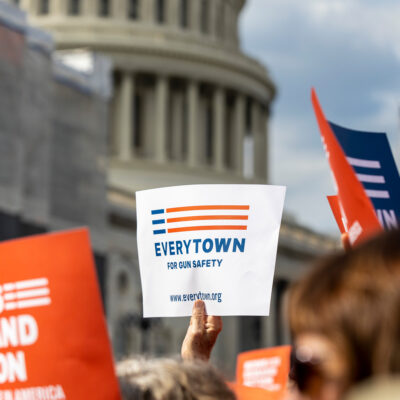Red Flag Laws Are Long Overdue In Texas: Here is What you Need to Know About the Shooting at Lakewood Church
2.13.2024
On Sunday, a woman wielding a long-gun entered a megachurch in Houston, Texas just as a Spanish-language service was beginning. Two people, including the shooter’s seven year old child, were wounded in the shooting.
As we continue to learn more details, one thing is clear: This atrocity may have been avoidable if Texas had enacted common sense gun laws. Texas has weak gun laws, including lacking an Extreme Risk law (also known as a Red Flag law), that empowers loved ones or law enforcement to temporarily prevent people at risk of causing harm from accessing firearms, including people who have threatened violence.
The shooter reportedly had a history of mental health crises and arrests, including for illegal possession of a weapon, and her mother-in-law specifically cited an Extreme Risk law as a tool that could have prevented the shooting. The shooter’s mother-in-law is reporting that had a particular type of schizophrenia that caused her to become violent, and they have received help from child protective services and the police several times. Yet, the shooter was still allowed to own guns. Had an Extreme Risk law been in place, and based on reports of her mental health history and other warning signs, the shooter’s family or law enforcement could have petitioned the court to issue an Extreme Risk Protection Order to prevent the shooter from gaining access to a firearm.
“Like so many tragedies, this could have been prevented with a Red Flag law in place,” said Nick Suplina, SVP of Law & Policy at Everytown for Gun Safety. “While we’re still learning more, it’s clear that this individual displayed troubling warning signs. Research proves that Red Flag laws work, and Texas lawmakers should listen to the vast majority of Texans who support common sense gun safety legislation and take immediate action to prevent future tragedies.”
Red Flag laws work and can save lives.
Currently, twenty-two states and the District of Columbia currently have Extreme Risk laws on the books. Following the shooting at Marjory Stoneman Douglas High School in Parkland, Florida, then-Governor Rick Scott and a Republican dominated legislature signed a Red Flag law. Since the creation of Florida’s Red Flag law Florida authorities have petitioned more than 10,000 times to keep guns out of the hands of people deemed a risk to themselves or others, according to data maintained by the Office of the State Courts Administrator.
And today in Michigan, the state’s new Extreme Risk Protection Order law went into effect, passed in the weeks following last year’s mass shooting at Michigan State University that took place one year ago today.
Today, the Everytown Support Fund re-launched the ‘One Thing You Can Do’ website – a resource center for how to use this life saving tool in states with ERPO laws. Along with information about Extreme Risk laws, and information to demystify this critical tool, the site also provides extensive resources on how to file an ERPO in your state, including direct links to court forms in both English and Spanish. There are also downloadable FAQ resource pages to help spread awareness about ERPO. More information about filing an extreme risk law can be found here.




